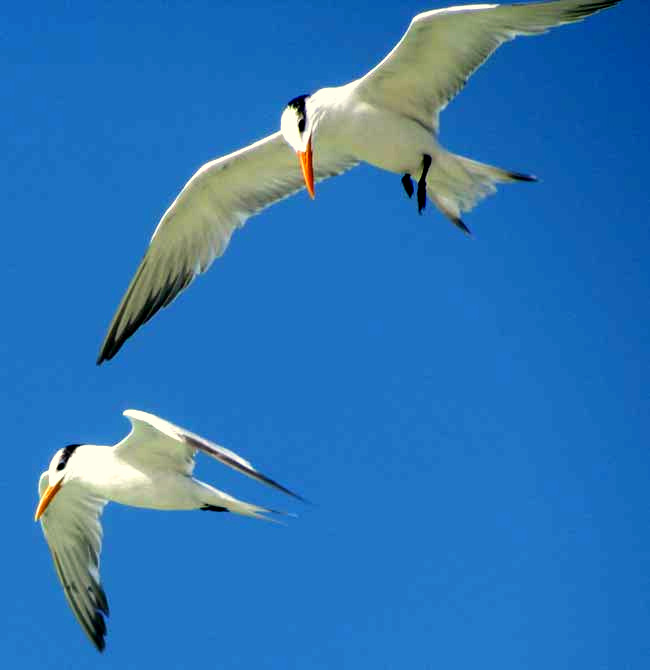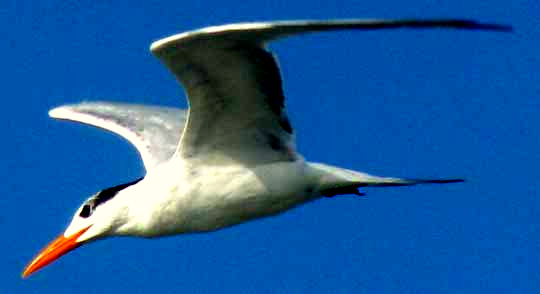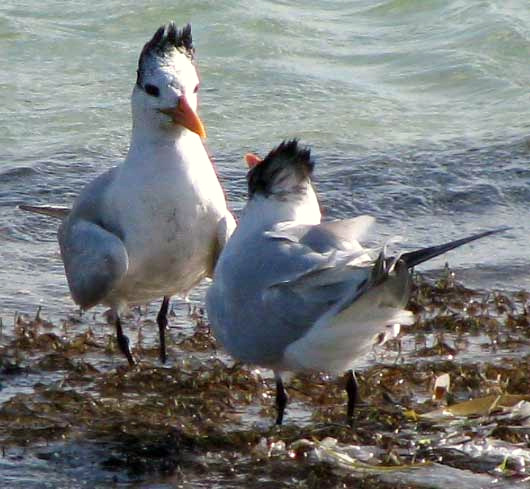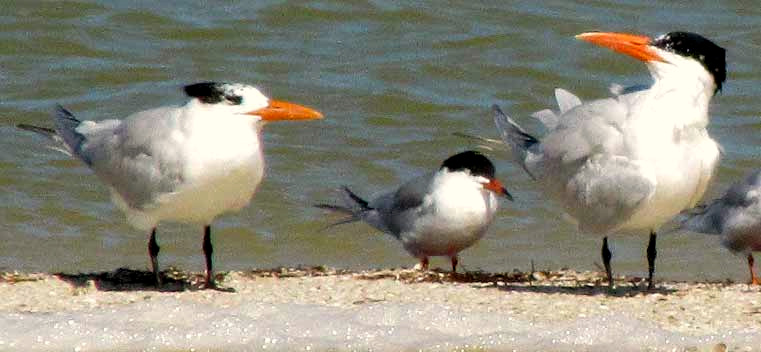Excerpts from Jim Conrad's Naturalist Newsletter

from the May 8, 2011 Newsletter issued from Mayan Beach Garden Inn 20 kms north of Mahahual; Caribbean coastal beach and mangroves, ~N18.89°, ~W87.64°, Quintana Roo state, MÉXICO
LINGERING ROYAL TERNS
Royal Terns are known as winter residents in this area, migrating northward for the summer. Still, here in May we still have a few -- in winter plumage -- as shown above. Howell in A Guide to The Birds of Mexico and Northern Central America reports a couple of isolated breeding colonies of Royal Terns in the Bay of Campeche across the Yucatán Peninsula, and "possibly also off Belize," so maybe it's impossible to know whether the birds I'm seeing now are late migrating northward, or intend to stay here all summer.
Since migration patterns are changing as global warming takes place, I figure it's a good idea to note document unusual occurrences, for researchers trying to make sense of the matter. The above picture was taken here on May 3rd.
Brown Pelicans, Semipalmated Plovers, Ruddy Turnstones and Blue-winged Teal also are mostly winter visitors here, except for a few isolated breeding colonies, but I'm still seeing them here, too.
APPENDIX DATED JULY 24, 2011: At this date even still each day several Royal Terns fly by, in the plumage shown below:

from the December 29, 2008 Newsletter issued from Mayan Beach Garden Inn 20 kms north of Mahahual; Caribbean coastal beach and mangroves, ~N18.89°, ~W87.64°, Quintana Roo state, MÉXICO Above you see a bird species occasionally showing up along the beach here. The birds are terns, not gulls. The family Laridae comprises the Gull Subfamily, the Tern Subfamily and the Skimmer Subfamily. Terns differ from gulls in that gulls possess relatively small, stout, hooked bills and, usually, rounded tails, while the bills of terns average somewhat larger, are pointed instead of hooked, and tern tails are forked. The birds in the picture are Royal Terns, THALASSEUS MAXIMUS, and a confrontation seems to be taking place. When I showed the picture to Marcia, the hotel owner, she told me that a while back an ornithologist staying at the hotel told her that immature Royal Terns are famous for "acting out" in front of their parents. Sometimes the parents reciprocate with a bit of defensiveness but other times they just stand calmly and let the tantrum pass. I can't say for sure what's happening in the picture -- even whether the angry-looking one is an immature or not -- but learning this about immature Royal Terns makes tern watching more interesting now. Royal Terns are one of three Mexican-tern species with black crests, and in the picture you can see how the crests can be raised. Usually the crest points backward giving the bird's head a flat-topped, swooped-back look but the bird in the picture with his crest erect looks almost horned. As the picture shows, Royal Terns in winter plumage have white foreheads. Only for a short time during the species' breeding season does a solid black cap develop. Royal Terns are very similar to Elegant Terns, but Elegant Terns don't occur on Mexico's Gulf/Caribbean side, only on the Pacific. Royals can most easily be confused with Caspian Terns, but that species is larger, has a blood-red bill instead of the Royal's orangish one, and its tail is less deeply notched. Royal Terns are strong flyers and strictly limited to saltwater, unlike some tern species who range inland. Royals occur from northwestern Mexico and the eastern US south to Peru and Argentina, and locally in western Africa. Most tern species feed by plunge-diving for fish near the surface.
A FEISTY ROYAL TERN

from the March 15, 2015 Newsletter issued from Río Lagartos, on the Yucatan Peninsula's northern coast (~N21.60°, ~W88.16°), Yucatán state, MÉXICO
THREE TERNS ON A MUDFLAT
During a flamingo-viewing trip we passed a mudflat loaded with Black Skimmers, Laughing Gulls, White Pelicans and terns. It was the terns who caused us to turn the boat back, park and study awhile, because something didn't seem right here. You can see the situation below:

The little tern in the middle is a Forster's Tern, very common here at this time of year. Of the tern species found in our area, the two largest are the Royal and Caspian Terns, and the two terns flanking the Forster's are definitely of the larger kind. We always say that the Royal Tern's beak is orangish, while the Caspian's beak is red. The confusing thing is that the two big terns in the picture clearly are different from one another, yet they both have orangish beaks. Caspian Terns are bigger than Royal Terns, with more massive beaks and their winter plumage includes darker foreheads, so we thought that the bird at the right should be a Caspian with a red beak, not orangish.
Finally we found in Howell's A Guide to The Birds of Mexico and Northern Central America a description of the juvenile Caspian Tern's beak, saying that it's "reddish orange to orangish with dark tip." Well, our bird's beak if anything is pale tipped, but at least now we know that immature Caspian Terns can have orangish beaks.
Immature birds and adults in winter plumage, which is the case with most birds in the estuary at this time of year, can be real challenges.